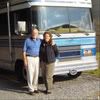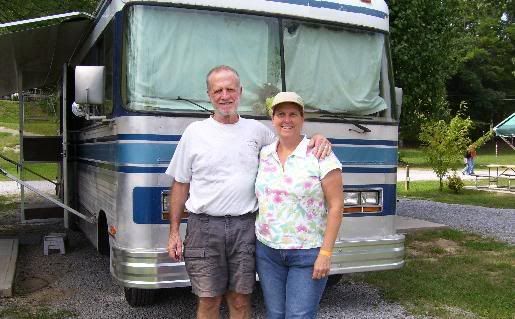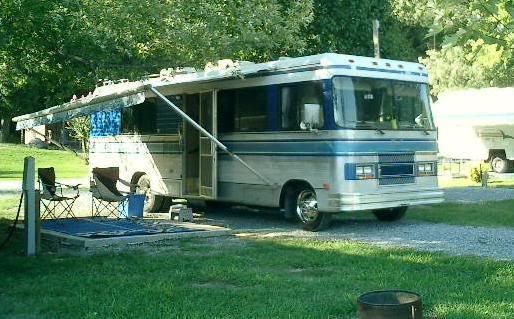Page 1 2
Go to...  | Start A New Topic  | Search  | Notify  | Tools  | Reply To This Topic  |  |
 6/12 6/12Formally known as "Humbojb"  |
Barth prewired my 85 Barth front TV location for both 110 and 12 volt circuits. Previous owner activated the DC circuit for the TV he had. I’m replacing it with an AC TV. Installed proper plug in the TV location. Other end of the line was in the rear underneath the street side twin bed. It was just laying there. Trying to figure out where to hook it up. Can’t find any out lets that might be available. But there is a junction box that is hot all the time, even when the transfer switch is in neutral or generator. Only way it goes off is to disconnect the shore line. One of two lines from the transfer switch goes to this junction box, the other going to the main 110 breaker panel. There’s one line going out of this junction box thru a hole in the floor to some unknown destination. This “circuit” appears to be unfused. Should I use it for the 110 TV circuit? A related question: When parked at home, the Barth is hooked up to our satellite system we use for the house. Has its own box for the TV and everything. You plug the satellite feed into the box etc. But when traveling, campground cable hookups don’t use boxes. So, I figured that I’d just use a splitter, feed the box with one side of the splitter and the TV with the other. Then if I was at a campground, I’d just not turn the box on and the TV would be getting a signal direct from the campground cable system. Sounds cool right? Yeah, but it doesn’t work. With both leads off the splitter hooked up, the satellite feed doesn’t work at all. Have to disconnect the direct lead to the TV. Is there some kind of a switch to use so you can go back and forth between park cable and satellite? Thanks folks Jim
| |||||||||||
|
 6/12 6/12Formally known as "Humbojb"  |
Can't believe I wrote this post. It actually sounds like I'm a least able to communicate.
| ||||||||||||
|
Captain Doom |
My Breakaway has a 120VAC outlet in the compartment over the driver's side of the front. A relay disconnects the 120VAC when the ignition is on. A splitter won't work the way you propose, as it has one input and two outputs; for it to work one of the outputs would have to double as an input and output to the other output (got it? You need a switching box which permits multiple inputs and multiple outputs. You might be able to get one at Radio Shack. I have the RS 15-2100A (apparently discontinued). In any event, you'd need one with coax inputs; outputs could be either component video (Sound L & R, S-Video) or coax. TV antenna, satellite converter, and park TV would be inputs (as could DVD or VCR be also), outputs would go to the TVs and DVD/VCR. Rusty '94 28' Breakaway: MilSpec AMG 6.5L TD 230HP Nelson and Chester, not-spoiled Golden Retrievers Sometimes I think we're alone in the universe, and sometimes I think we're not. In either case the idea is quite staggering. - Arthur C. Clarke It was a woman who drove me to drink, and I've been searching thirty years to find her and thank her - W. C. Fields | |||
|
"There’s one line going out of this junction box thru a hole in the floor to some unknown destination. This “circuit” appears to be unfused. Should I use it for the 110 TV circuit?" Is the floor-hole line perhaps the INCOMING 110v feed from shore power? What size wire, and is it 3-wire cable (like Romex)? Next: 1) Do you have 30 or 50 amp shore power? ('85 probably has 30 amp) 2) "Other end of the line was in the rear underneath the street side twin bed. It was just laying there..." Does this line have a male plug;female receptacle; or other end device? or has it been cut off? How do you know this is the "line" to the TV? Is the junction box under the same bed? Where is the CB panel - same place? "..junction box that is hot all the time, even when the transfer switch is in neutral or generator.." Is this box hot when the generator is running? Is it hot when the generator is not running and shore power is not connected? DON'T HOOK THIS UP (TO ANYTHING) UNFUSED. What "junction" is in the junction box? This is probably simple once you figure out the wiring path. Please answer. "You are what you drive" - Clint Eastwood | ||||
|
 6/12 6/12Formally known as "Humbojb"  |
The Regal is 30 Amps. The 110 Volt wiring diagram shows a wire running from the front tv location rearward. The drawing shows no termination for that wire. Same thing for the dc circuit for the tv. The wire was laying in the space under the street side rear bed where all the other electrical stuff is located. It was just cut off, wires not stripped.No plug or receptacle either end. The junction box has a wire going to it from the manual transfer switch. The other wire comes out of the floor. Both look like they are 12-2 with ground but the one coming out of the floor is not solid copper--braided instead. Junction box is hot as long as the shore line is plugged in to an external source. The reason I say it unfused is that even when you flip the 30 amp disconnect in the breaker panel, it's still hot. Haven't checked the question about the generator yet.
| ||||||||||||
|
[B]"The junction box has a wire going to it from the manual transfer switch. The other wire comes out of the floor. Both look like they are 12-2 with..."[/B Are these two lines connected inside the junction box so that one feeds the other? In other words, are the transfer switch cable and the hole-in-the-floor-cable tied together inside the junction box? Are any other wires inside the junction box? Other: Is the "hot" in the junction box 110v (as opposed to 12V DC control wiring)? Is the wire from the manual transfer switch to the junction box 110v or 12VDC? I may be getting carried away with this -apologies if so, and I'll stop. G "You are what you drive" - Clint Eastwood | ||||
|
 6/12 6/12Formally known as "Humbojb"  |
Gunner, I really appreciate your help. The two wires in the junction box are joined together. The one from under the floor is from the shore power cord. Sort of feel stupid I didn't see that right away. So the other wire is going to the the transfer switch rather than coming from it. So I'm back to where I started. The breaker box has no place for any new circuits. Maybe I can cut one of the existing circuits that is in the area where the end of the tv wire is, put in a new junction box, and then connect all three wires together. Any other ideas?
| ||||||||||||
|
"The breaker box has no place for any new circuits. Maybe I can cut one of the existing circuits..." Here's the plan: 1) "Double" or "Piggyback" breakers are available. They are the same size -except half the width- as the existing 15 or 20 amp breakers in the box, but they have two "toggles" instead of one. It is two breakers half the width of the traditional ones you have; or some have two toggles, top & bottom in the same size case as the original you are replacing. (This is NOT a "doublepole" breaker) Buy a piggyback to replace one of the breakers in your box and insert the TV wire into the outbound slot on one of the two; the original outbound wire goes into the other half of the piggyback. Home Depot, Lowe's, et al carry these. nb: This does not increase the capacity of your 30amp service; the main will still trip over 30 amps. OR: 2) insert the TV wire into the outbound terminal of any existing breaker, preferably one which is unloaded when the TV is on. Loosen the holddown screw, insert the TV wire into the slot with the existing wire, and tighten. REMEMBER: You MUST insert the white -neutral- wire into a neutral slot on the neutral strip where the other neutral wires are secured -again, if there is no empty slot pair the TV neutral with an existing. Finally: the third, probably small bare wire, is the ground and must go into a slot on the Ground strip. If you can't get to the CB panel from the TV cable, yeah: cut an existing cable, run it through a box, and tie the 3 black, white, and grounds together inside the box. Unfortunately, when you cut a cable, usually there isn't enough slack to run it through a box!! And, of course, no junctions outside a box - ever. Finally Finally: Unplug the shore power and turn the main (30amp) breaker off before removing any breakers. If you haven't actually removed a breaker before, most all come out by pulling (or using a flatblade screwdriver to pry) outward and down; install by setting the bottom rear into a press slot and pushing up and in on the top front of the breaker. If this is too basic, tough cookies - others less experienced may read this post. Good luck "You are what you drive" - Clint Eastwood | ||||
|
 6/12 6/12Formally known as "Humbojb"  |
Thanks Gunner. Will tackle it tomorrow. Jim
| ||||||||||||
|
 6/12 6/12Formally known as "Humbojb"  |
Found a 110 outlet in the rear bath closet that was the end of the circuit. So, hooked it up and everything is working fine. Thanks for all the help Gunner and others. Next project, convert from 30 amp to 50 amp. Some previous owner had added a couple of potentially heavy circuits plus a second a/c unit, so I said, heck lets do it right and convert the whole thing to 50 amps. I know I'll need a 50 amp shore cord, 50 amp transfer switch but not sure if I need to replace the converter.?? I've heard of a 'kit'. Has anybody else?
| ||||||||||||
|
 6/12 6/12Formally known as "Humbojb"  |
I have an Inteli-Power 9100 Power Converter/Battery Charger Model PD9160A hooked to an Inteli-Power 9100 computer controlled battery monitor/charging module charge wizard. Would this converter work with a 50 Amp set up?
| ||||||||||||
|
Captain Doom |
It would - the converter only uses 120VAC, however. 12VDC connections would remain unchanged (actually so would the 120VAC connections). All the 50A facility does is to split the load between two legs. Most 50A motorhomes don't use the 240 VAC (unless there's a clothes dryer installed - they just use the two 120VAC legs to common for 120VAC throughout the coach). Rewiring to 50A will be relatively simple but will require a new power panel/breaker box with facilities for two legs. Half the 120VAC circuits will be on one leg, the remainder on the other leg. The loads should be balanced by potential current draw, not the number of circuits. BTW, I was at my Friendly Local RV Dealer yesterday having a new A/C installed, and notice he had several video switch boxes for coax cable; prices ranged from $58 to $83. Rusty '94 28' Breakaway: MilSpec AMG 6.5L TD 230HP Nelson and Chester, not-spoiled Golden Retrievers Sometimes I think we're alone in the universe, and sometimes I think we're not. In either case the idea is quite staggering. - Arthur C. Clarke It was a woman who drove me to drink, and I've been searching thirty years to find her and thank her - W. C. Fields | |||
|
"..added a couple of potentially heavy circuits plus a second a/c unit....'\" The added stuff wasn't the original gear, ergo you can do without it whenever you only have 30amp (or -heaven forbid!- 20 amp) service available. Therefore, I propose a cheaper, simpler conversion which won't require a new (expensive!) transfer switch. Replace the 30amp shore cord with a 4-wire (red, black, white, green) 50 amp cord. If it enters the coach in a compartment, terminate it in a junction box upstream of the transfer switch; otherwise, install a junction box near the existing panel. Tie the existing 3 (B,W,G) coach wires into the new shore B,W,G. The new RED wire, along with W & G splices, will feed a new, entirely separate, 120v breaker box. The added stuff (A/C, etc) will be disconnected from the existing and now fed out of the new box; it won't be available when you don't have 50 amp service, of course, nor from the converter, but it wasn't available anyway. Primer: "50 amp" coaches have an adapter cord which allows them to plug into 30amp (and 20) service. This adapter simply lacks one (Red) wire, so all that exits the adapter is B,W,G -120 volts, instead of B,R,W,G -220v. Said coaches typically have appliances e.g. elec. water heater, 2nd & 3rd A/C, dryer - on the "Red wire" so they will not operate on 30 amps. I added a 220v electric heater -which, of course, is only available on 50amp shore power- using a method similar to this. It cuts the amperage in half so I have a good-sized heat source at, effectively, half the price; or, re the propane furnace, NO cost. The new wires will not be connected to the converter or the generator, of course. Do you need these "extras" when you're not on 50amp shore? Don't dismiss this idea out of hand; give it some thought. p.s. I did this in a hurry; if there are flaws in the electric part please speak up. "You are what you drive" - Clint Eastwood | ||||
|
 6/12 6/12Formally known as "Humbojb"  |
OK, let's see if I understand this. Since I already have two breaker boxes, I would just split the new 50 amp cable, direct half of it to the existing transfer switch and the other half to the second breaker box. I wouldn't need a new transfer switch. But am I right in saying that if I was on generator power, I would have only half of the 50 amps available, i.e., the half that was wired to the transfer switch? But if I was hooked up to 50 amp shore power the second a/c which I would wire into the second breaker box would be able to run at the same time that that the first a/c was running. If I was hooked up to a 30 amp shore supply, which breaker box would be supplied?
| ||||||||||||
|
 6/12 6/12Formally known as "Humbojb"  |
Hey Rusty, were those video switch boxes for going back and forth between satellite feed and cable feed using one coax cable? Do you remember the manufacture? Thanks. Jim
| ||||||||||||
|
| Powered by Social Strata | Page 1 2 |
| Please Wait. Your request is being processed... |
|
This website is dedicated to the Barth Custom Coach, their owners and those who admire this American made, quality crafted, motor coach.
We are committed to the history, preservation and restoration of the Barth Custom Coach.
We are committed to the history, preservation and restoration of the Barth Custom Coach.



